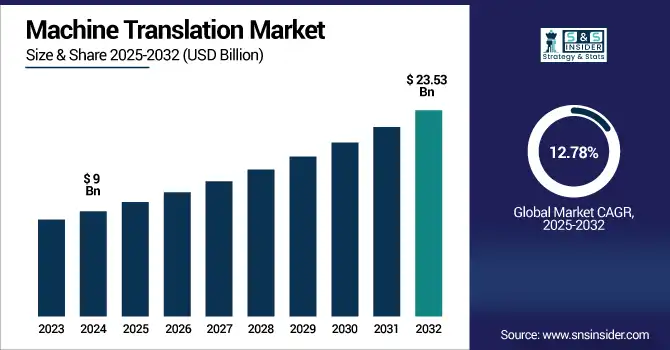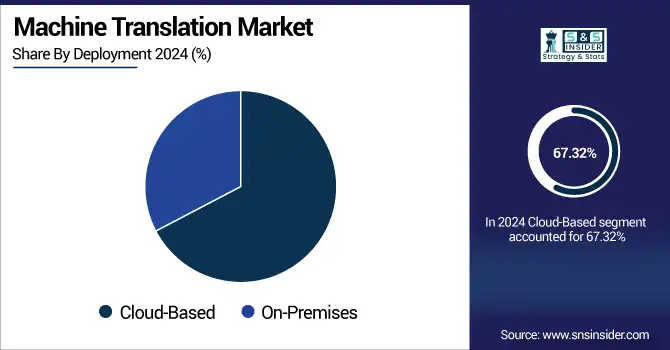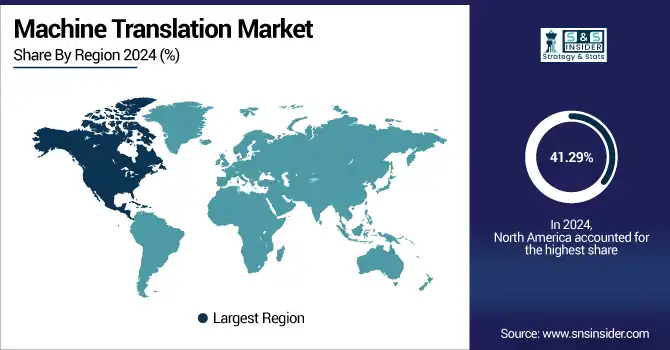Machine Translation Market Report Scope & Overview:
The Machine Translation Market size was valued at USD 9 billion in 2024 and is expected to reach USD 23.53 billion by 2032, expanding at a CAGR of 12.78% over the forecast period of 2025-2032.

To Get more information on Machine Translation Market - Request Free Sample Report
The rapid growth of the Machine Translation Market is driven by these growing demands of any industry, such as the need for real-time, multilingual communication. Powered by artificial intelligence and neural networks, machine translation enables companies to limit their dependency on human translators and accelerate content localization. Industry-leading sectors like IT, healthcare, and e-commerce are embracing these solutions to offer better global access and customer experience. Moving towards cloud-based models and integrating with AI tools opened the way for higher scalability and efficiency. Though neural machine translation (NMT) and NLP still face challenges such as contextual accuracy and data privacy, they are producing better output as the technology evolves. Asia-Pacific is predicted to be the fastest-growing market owing to digital growth and globalization.
According to research, over 80% of global digital content requires localization, and over 40% of AI-driven customer support in multinational firms is now translated in real time using machine translation systems.
The U.S Machine Translation Market size reached USD 1.55 billion in 2024 and is expected to reach USD 3.67 billion in 2032 at a CAGR of 11.36% from 2025 to 2032.
The technological sophistication, high content generation, and early acceptance of Artificial Intelligence (AI) and Neural Machine Translation (NMT) solutions, the U.S. leads the pack when it comes to the global market. The machine translation market growth is primarily attributed to the strong presence of the key market players, the high R&D investment in the product, and the growing requirement for real-time multilingual communication among various industry verticals such as healthcare, IT, and e-commerce. These include a growing demand for customer service localization, regulatory compliance, and international business development that drives many U.S. enterprises to apply machine translation tools.
Machine Translation Market Dynamics
Drivers:
-
Rising Demand for Real-Time Multilingual Communication Across Global Enterprises.
The growing demand for instant multilingual communication is the primary driving factor of the machine translation market. With global enterprises operating in wider borders than ever before, the world requires effective translation solutions to help communicate properly, remobilising towards diverse audiences in a hassle-free way. With the introduction of NMT and additional adaptive AI functionalities, translation services have captured the infiltrate accuracy and understand context information, enabling businesses to localize content well. One of the recent advancements is their application of large language models (LLMs), which help in improving the translations by understanding intricacies and cultural nuances. Such innovations are extremely useful in sectors like e-commerce, healthcare, and IT, where communication needs to be instant and accurate.
Restraints:
-
Limitations in Contextual Understanding and Cultural Nuance in Machine Translations.
With technological advancements, machine translation systems usually fail to grasp context and cultural nuances. This is especially the case with idioms, colloquialisms, or emotionally nuanced content where a literal translation could lead to awkward phrasing or an entirely different meaning. Such restrictions often result in misunderstanding or even offense, and as a result, the user experience and reputation of the brand can be negatively affected. Moreover, they often do a poor job with specialized terminology or domain-specific language, requiring human review and post-editing for accuracy and appropriateness.
Opportunities:
-
Advancements in Multimodal Machine Translation Enhancing Translation Accuracy and User Experience.
Multimodal machine translation (MMT) development offers extensive potential for improvement for translation precision and user experience. It combines text, audio, and visual inputs to give more context-oriented translations, which is useful in multimedia content like videos, images, and live transmissions. Improvements in this direction are made possible by the use of visual encoding and audio processing that enable translation engines to understand and translate content better. With many organizations looking to offer immersive and inclusive experiences to wider audiences around the world, we anticipate the continued growth of the MMT approach.
Challenges:
-
High Costs Associated with Research and Development of Advanced Translation Technologies.
Research and development (R&D) expenditure on the creation and national adoption of cutting-edge machine translation technologies can run into billions. The development of more advanced translation models necessitates a considerable investment in hardware, data procurement, and human capital. The problem with these high costs is they can be a barrier to entry for smaller companies and startups, which can be a limitation for innovation and competition in the market. Additionally, it can be costly to maintain and update language models to ensure they stay current with changes in language use and industry needs. Resolution of these issues is fundamental for the long-term sustainability and democratization of machine translation technologies.
Machine Translation Market Segment Analysis
By Technologies
The SMT segment accounted for the largest share of revenue of 45.40% in 2024, owing to its long-standing history, simplicity, and reliability in structured language translation. Where large parallel corpora can be found, such as in government and enterprise-level translation tasks, SMT systems have come into common use. Historically, document translation services have used SMT-based platforms, as seen in products from companies like IBM and SDL. Due to its accuracy and predictability with the underlying rules, it is helpful in translating technical documents and manuals. The need for domain-specific language tasks is consistent output.
The Neural Machine Translation (NMT) segment is estimated to grow at the fastest CAGR of 14.68% during the forecast period. NMT employs deep learning and artificial intelligence to generate human-like translations, improving the quality of output. Prominent actors like Google (NMT engine for Google Translate) and Microsoft (Azure Cognitive Services) are pursuing rapid developments in their AI translation technology. This demand is fueled by the rise of real-time, accurate translations across Customer Service, digital content, and cross-border communication. The move of businesses towards smarter processes using these systems is backed by the ever-increasing demand from the market for automation and personalization that can be offered with the scalability and accuracy of NMT.
By Deployment
In 2024, the on-premises deployment segment held the largest revenue share of 32.87%, which can be attributed to the growing emphasis on data security, privacy, and regulatory compliance, especially in sensitive sectors. For example, agencies, defense organizations, and financial institutions that require significant control over translation workflows and proprietary content prefer on-prem solutions. Enterprise and military-focused companies such as SYSTRAN and Lionbridge offer on-premises solutions that are secure. The driver for this segment is the stringent requirement of data protection and offline availability, particularly in regulated industries.
The cloud-based deployment segment is projected to register the fastest CAGR of 12.46%, owing to growing digital transformation and remote accessibility requirements. Cloud-based solutions provide power and scalability, cost efficiency, and seamless integration with multiple platforms and APIs. Top vendors, including Amazon and DeepL, provide strong cloud-native services that can be fully configured and accessed worldwide. This segment is driven by an increasing demand for optimized, scalable translation tools among SMEs and content-driven industries. Despite traditional integration issues, cloud deployment allows for rapid updates, real-time collaboration, and training of AI models, which is why it is fast becoming the standard for agile businesses with a global footprint.

By Application
The e-commerce and retail segment accounted for 41.39% of the machine translation market share in 2024, owing to the increasing requirement to connect with customers nationwide and globally and to provide localized information on products or services provided by the sector. Machine Translation Tools: Used in Websites of Businesses such as Alibaba, Amazon, and Shopify, machine translation tools are integrated to help businesses provide multilingual customer support, localized product descriptions, and seamless user experiences. In this case, the primary use case is a need for fast, at-scale, accurate translation to enable selling globally and improving customer retention.
The healthcare segment is expected to record a CAGR of 14.05% during to forecast period owing to the need for multilingual and accurate communication between healthcare providers and patients. Machine translation is a bedrock technology that hospitals, telehealth platforms, and medical research institutions use to power multilingual patient documentation, prescriptions, and medical content. Domain-specific NMT There are machine translation companies like IBM Watson Health and Google Health that are actually working on respective NMT models, which are targeted specifically for medical accuracy. The main growth facilitator is the focus on patient safety, inclusivity, and regulatory compliance in multilingual environments.
Machine Translation Market Regional Outlook
North America holds a 41.29% share, due to the presence of major tech companies, accompanied by a high rate of digital adoption, along with a significant demand for a multilingual communication solution from the healthcare, e-commerce, and government sectors. Numerous early adopters of AI-powered solutions, along with advanced R&D infrastructure, enable further growth of the market in this region.
The U.S. dominates due to its leading edge in technology, the investment in AI and NLP, and the proliferation of machine translation for large enterprises and public sector organizations.
Europe, because of its diverse languages, stringent regulatory standards, and rising localization demand, holds a significant share in the machine translation market. Demand is fed by sectors such as legal, automotive, and tourism, while EU language policies promote the use of translation technologies among member states.
Germany dominated the European market, owing to its strong manufacturing and engineering sectors, the requirement of localized technical documentation, and the use of AI translation tools.
Asia Pacific is the region with the fastest CAGR of 13.98%, driven by growing internet penetration, a large number of regional languages, and the fast pace of business globalization. E-commerce, education, and customer services sectors are dominant drivers of adoption, particularly in emerging economies such as India and Southeast Asia.
China leads the regional market due to government-supported AI programs, a robust tech ecosystem, and massive applications of translation in e-commerce and government services.
The Middle East & Africa and Latin America machine translation market is growing steadily as a result of digital transformation, multilingual communication requirements, and increasing online content consumption. The top sectors for machine translation are tourism, education, and retail, with the UAE and Brazil being the leaders based on their robust digital and AI programs.

Get Customized Report as per Your Business Requirement - Enquiry Now
Key Players
The major key players of the machine translation market are Google LLC, Microsoft Corporation, Amazon Web Services, IBM Corporation, DeepL GmbH, SYSTRAN International, SDL plc, Lionbridge Technologies, Baidu, AppTek, and others.
Key Developments
-
In May 2025, SYSTRAN collaborates with Sinequa to bring AI legal assistants together with multilingual eDiscovery, improving productivity and unlocking new value in legal workflows worldwide.
-
In May 2025, Lionbridge Smart MT solution takes home the "Best Machine Translation Solution" award at the 7th Annual AI Breakthrough Awards, using Large Language Models to improve translation quality and efficiency.
| Report Attributes | Details |
|---|---|
| Market Size in 2024 | USD 9 Billion |
| Market Size by 2032 | USD 23.53 Billion |
| CAGR | CAGR of 12.78% From 2025 to 2032 |
| Base Year | 2024 |
| Forecast Period | 2025-2032 |
| Historical Data | 2021-2023 |
| Report Scope & Coverage | Market Size, Segments Analysis, Competitive Landscape, Regional Analysis, DROC & SWOT Analysis, Forecast Outlook |
| Key Segments | •By Technologies (Statistical Machine Translation (SMT), Rule-Based Machine Translation (RBMT), Neural Machine Translation (NMT), Hybrid Machine Translation (HMT), Example-Based Machine Translation (EBMT), Other Technologies) •By Application (E-commerce and Retail, Travel and Hospitality, Legal and Government, Manufacturing and Automotive, Healthcare) •By Deployment (Cloud-Based, On-Premises) |
| Regional Analysis/Coverage | North America (US, Canada, Mexico), Europe (Germany, France, UK, Italy, Spain, Poland, Turkey, Rest of Europe), Asia Pacific (China, India, Japan, South Korea, Singapore, Australia, Rest of Asia Pacific), Middle East & Africa (UAE, Saudi Arabia, Qatar, South Africa, Rest of Middle East & Africa), Latin America (Brazil, Argentina, Rest of Latin America) |
| Company Profiles | Google LLC, Microsoft Corporation, Amazon Web Services, IBM Corporation, DeepL GmbH, SYSTRAN International, SDL plc, Lionbridge Technologies, Baidu, AppTek |

